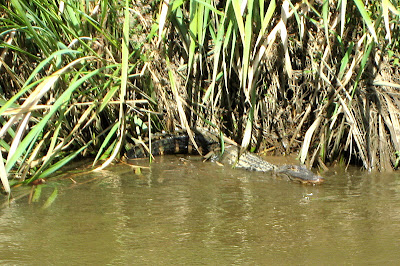At 5 AM the windows flashed with distant lightning and something began to clank against the trailer. I prowled around once and couldn’t find it and on my second prowl I partially lowered the awning to allow for rain, and the noise went away. The rain finally came, in a downpour, just as we were trying to leave for a tour.
The tour was of Brookgreen Gardens, and the rain fortunately ended on our arrival. This place is immense and beautiful, constructed by Archer and Anna Hyatt Huntington in the 1930s to display American sculpture and to feature native plants of the south-east.
Yes, this is another branch of the Huntington family, he an adopted son of Collis Huntington of California railroad fame and wealth. (The California branch, in addition to everything else they owned, for many years owned Standard Felt Company, where my dad worked his entire career.)
Brookgreen is every bit a worthy rival for the Huntington Library and Gardens in San Marino CA, only friendlier. The gardens are less formal, the sculpture more modern, and there are no wandering guards. Also no paintings of a very stern, dark-clothed and altogether frightening Mrs. Huntington. This Mrs. Huntington is attractive and is portrayed as a confident sculptress, pausing in her work as if the painter has asked a slightly amusing question. (She was a very talented sculptress, but I’m sure the Huntington money didn’t hurt any.)
The Huntingtons bought in Myrtle Beach in the 1930s hoping the climate would help Mrs. Huntington's tuberculosis (she later found a cure in Switzerland). They built a compound on the ocean side of the highway, now part of Huntington Beach State Park. Brookgreen is on the inland side and is over 10,000 acres.
This land was originally part of a huge 17th century rice plantation. Note the photo showing live oaks; they bordered the entry drive to the original plantation house, and yes, George Washington once tread (or much more likely road) this very route on a documented visit.
Why was he visiting? The owner was a friend, but politics is also politics; the man was wealthy beyond imagination, owning nine rice plantations and over 1000 slaves. He had power.
Rice growing declined rapidly in the low country after the Civil War because it was highly labor intensive, and the labor now cost money. The lands were too squishy for mechanical equipment so rice growing moved elsewhere. The plantation home, long abandoned, burned down in 1901.
Brookgreen Gardens today acknowledges this past with well-done displays describing plantation life. In the 1980s or 1990s the trust received permission to re-flood much of the old rice growing area, and it is now managed to promote water fowl and native animals. Our tour included a boat ride and we actually saw a couple alligators.







No comments:
Post a Comment